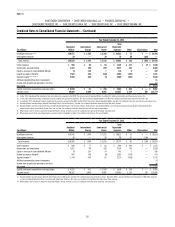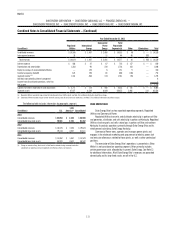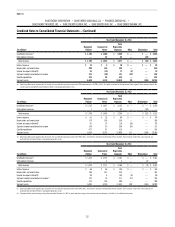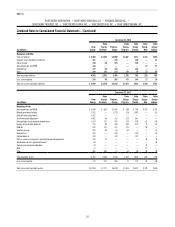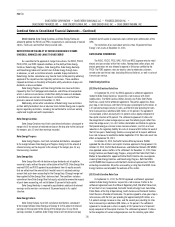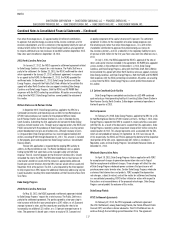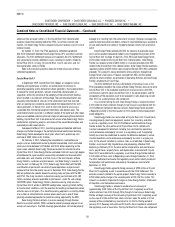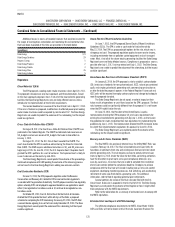Duke Energy 2013 Annual Report Download - page 133
Download and view the complete annual report
Please find page 133 of the 2013 Duke Energy annual report below. You can navigate through the pages in the report by either clicking on the pages listed below, or by using the keyword search tool below to find specific information within the annual report.
115
PART II
DUKE ENERGY CORPORATION • DUKE ENERGY CAROLINAS, LLC • PROGRESS ENERGY, INC. •
DUKE ENERGY PROGRESS, INC. • DUKE ENERGY FLORIDA, INC. • DUKE ENERGY OHIO, INC. • DUKE ENERGY INDIANA, INC.
Combined Notes to Consolidated Financial Statements – (Continued)
December 31, 2012
(in millions)
Duke
Energy
Duke
Energy
Carolinas
Progress
Energy
Duke
Energy
Progress
Duke
Energy
Florida
Duke
Energy
Ohio
Duke
Energy
Indiana
Regulatory Liabilities
Costs of removal $4,827 $1,928 $2,048 $1,503 $ 401 $236 $624
Amounts to be refunded to customers 290 — 259 — 259 — 31
Storm reserve 125 — 125 — 125 — —
Accrued pension and OPEB 103 — — — — 18 68
Deferred fuel 55 45 10 10 — — —
Other 340 207 55 35 20 39 29
Total regulatory liabilities 5,740 2,180 2,497 1,548 805 293 752
Less: current portion 156 78 28 10 18 39 11
Total non-current regulatory liabilities $5,584 $2,102 $2,469 $1,538 $ 787 $254 $741
Descriptions of regulatory assets and liabilities, summarized in the tables
above, as well as their recovery and amortization periods follow. Items are
excluded from rate base unless otherwise noted.
Accrued pension and OPEB. Accrued pension and OPEB represent
regulatory assets and liabilities related to each of the Duke Energy Registrants’
respective shares of unrecognized actuarial gains and losses, unrecognized
prior service cost, and unrecognized transition obligation attributable to Duke
Energy’s pension plans and OPEB plans. The regulatory asset or liability is
amortized with the recognition of actuarial gains and losses, prior service cost,
and transition obligations to net periodic benet costs for pension and OPEB
plans. See Note 21 for additional detail.
Retired generation facilities. Duke Energy Florida earns a reduced
return on a substantial portion of the amount of regulatory asset associated with
the retirement of Crystal River Unit 3 not included in rate base and a full return
on a portion of the retired plant currently recovered in rates. Once included in
base rates the amount will be amortized over 20 years. Duke Energy Carolinas
and Duke Energy Progress earn a return on the outstanding balance with
recovery periods ranging from ve to 10 years. Duke Energy Indiana earns a
return on the outstanding balances and the costs are included in rate base.
Asset retirement obligations. Represents future removal costs
associated with asset retirement obligations for nuclear facilities. No
return is earned on these balances. The recovery period runs through the
decommissioning period of each nuclear unit, the latest of which is estimated to
be 2097. See Note 9 for additional information.
Net regulatory asset related to income taxes. Regulatory assets
principally associated with the depreciation and recovery of AFUDC equity.
Amounts have no impact on rate base as regulatory assets are offset by
deferred tax liabilities. The recovery period is over the life of the associated
assets.
Hedge costs and other deferrals. Amounts relate to unrealized gains
and losses on derivatives recorded as a regulatory asset or liability, respectively,
until the contracts are settled. The recovery period varies for these costs, and
currently extends to 2027.
DSM/EE. The recovery period varies for these costs, with some
currently unknown. Duke Energy Carolinas, Duke Energy Progress, and
Duke Energy Florida are required to pay interest on the outstanding liability
balance. Duke Energy Progress and Duke Energy Florida collect a return on
the outstanding asset balance. Duke Energy Carolinas collects a return on the
outstanding balance in South Carolina.
Vacation accrual. Generally recovered within one year.
Deferred fuel. Deferred fuel costs represent certain energy costs that
are recoverable or refundable as approved by the applicable regulatory body.
Duke Energy Florida, Duke Energy Ohio, and Duke Energy Indiana earn a return
on under-recovered costs. Duke Energy Florida, Duke Energy Ohio and Duke
Energy Indiana pay interest on over-recovered costs. Duke Energy Carolinas and
Duke Energy Progress pay interest on over-recovered costs in North Carolina.
Recovery period is generally over one year. Duke Energy Florida amount includes
capacity costs.
Nuclear deferral. Includes (i) amounts related to levelizing nuclear plant
outage costs at Duke Energy Carolinas in North Carolina and South Carolina,
and Duke Energy Progress in North Carolina, which allows for the recognition of
nuclear outage expenses over the refueling cycle rather than when the outage
occurs, resulting in the deferral of operations and maintenance costs associated
with refueling and (ii) certain deferred preconstruction and carrying costs at
Duke Energy Florida as approved by the FPSC associated with Levy, expected to
be recovered in revenues by the end of 2017.
Post-in-service carrying costs and deferred operating expenses.
Represents deferred depreciation and operating expenses as well as carrying
costs on the portion of capital expenditures placed in service but not yet
reected in retail rates as plant in service. Duke Energy Carolinas, Duke Energy
Progress, Duke Energy Ohio and Duke Energy Indiana earn a return on the
outstanding balance. Duke Energy Ohio amounts are included in rate base. For
Duke Energy Indiana, some amounts are included in rate base. Recovery is over
various lives, and the latest recovery period is 2067.
Gasification services agreement buyout. The IURC authorized
Duke Energy Indiana to recover costs incurred to buyout a gasication services
agreement, including carrying costs through 2018.
Transmission expansion obligation. Represents transmission
expansion obligations related to Duke Energy Ohio’s withdrawal from
Midcontinent Independent System Operator, Inc. (MISO).
MGP. Represents remediation costs for former MGP sites. In November
2013, the PUCO approved recovery of these costs through 2018. Duke Energy
Ohio does not earn a return on these costs. See Note 5, Commitments and
Contingencies, for additional information.
Debt fair value adjustment. Purchase accounting adjustment to restate
the carrying value of Progress Energy debt to fair value. Amount is amortized
over the life of the related debt.
Costs of removal. Represents funds received from customers to cover
the future removal of property, plant and equipment from retired or abandoned
sites as property is retired. Also includes unrealized gains on NDTF investments.
Amounts to be refunded to customers. Represents required refunds to
retail customers by the applicable regulatory body. The refund period is through
2016 for Duke Energy Florida and through 2017 for Duke Energy Indiana.







